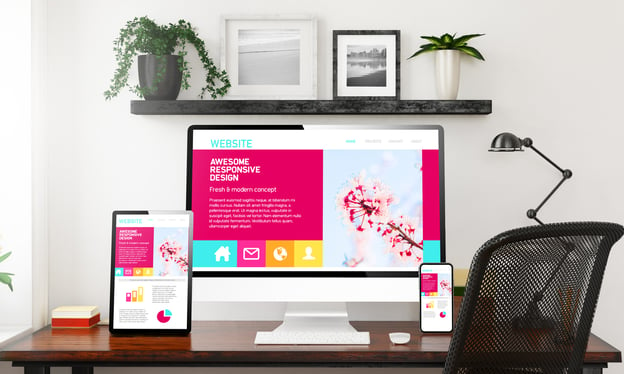6 Things to Consider Before Your Next Website Redesign
In today's digital era, websites are a must-have for any goal-oriented business looking to expand its customer base and maximize revenue. Speaking of which, did you know that the website design has a bearing on whether or not it attracts quality and quantity traffic?
A whopping 93% of visitors say they'd leave a website if it has a poor design. Mind-boggling, right?
If you have an existing site that's not performing as per your expectation, it might be time to do a partial (or complete) rewamp of your site.
Below is a list of the key considerations to help you keep your website optimized and future-oriented.

1. Analyze Your Current Website
It's common knowledge; you can't solve a problem whose root cause you don't know. The first step to an effective website redesign is jotting down what's working versus what's not. This enables you to have evidence-backed data on the features and aspects that need a revamp.
Here, you'll need to employ analytics to map out what's not working/valuable and needs to be dropped, what needs one-time improvement, and what needs incremental changes. For instance, you should note the pages that aren't getting visited, the CTAs that aren't getting clicked, the types of content receiving less attention, etc.
2. Monitor Your Competition
Ask any successful business, and they'll tell you that tracking their competitors' moves is always a part of their strategy. However, as you keep up with the competition, you want to stick to your brand and provide unique services and products only relatable to your business. The goal is to ensure you remain updated with the latest trends and technologies by gradually improving your design accordingly.
For instance, if your competitor offers a free quote or price calculator for the same products or services you provide, that could be a vital element to feature in your redesign. But first, remember to weigh out the upsides and downsides before introducing anything featured in your competitor's website in your redesign plan.
3. Set Your Goals for Your Website Redesign
Any project that takes your time and money must have set goals, and a website redesign is no exception. On top of revamping the structure, you should aim to make your new website SEO-friendly and marketing-optimized. There's nothing wrong with going for flashy looks, but over-stuffing it with visual features and fancy code may be detrimental to a website's loading time, page links, and navigation.
Below are a few best practices on how you can set goals for a growth-driven design:
- Put a number on any goal that you want to achieve. For instance, if your goal is to increase (by a certain percentage) the number of website visitors or leads, noting down the projection helps you develop a growth-driven strategy for realizing that feat.
- Don't set vague or over-ambitious goals. Something like "my new redesign should attract a million visitors per day" doesn't make sense. It would be nice, but unless it's a target you can realistically get to within a reasonable time-frame you should ease it down a notch. Likewise, stating that "it should look better" is very vague. Instead, set specific, achievable goals like, "the new design should have a clean look with sufficient white spaces."
- Target specific functionalities. Perhaps you want rotating testimonial sliders, more CTA buttons, more quick and easy-to-fill-out forms, etc. Even if you can't create all the functionalities at once, draft a growth-driven plan that'll enable you to make incremental adjustments as time progresses.

4. Define Your Target Audience
Defining your target audience begins by creating detailed buyer personas. These are a semi-fictional data-based representation of your ideal customers or users. Your type of target audience influence literally everything in the business, including the content strategy, customer experience, offers, products/services, sales follow-up processes, and more.
And there's more to defining your target audience than just knowing who they are. You must analyze their browsing styles, preferences, keywords they're using, how they'll find your website, etc. Having all this information will help you create a tailor-made redesign that addresses your customers' specific needs or problems. Also, taking the MVP approach enables you to gather as much validated information about your target customers using the least effort.
5. Leverage Analytics Tools for Your Website Redesign
Every redesign action that you take should be data-driven and outcome-oriented. You can't assume that a particular feature or aspect will work for your website while others won't. You need tools like Google Analytics to track and analyze exact website activities like bounce rates, pages per session, session duration, and more.
In essence, an analytics tool will accurately inform you of the key areas that need a redesign. For instance, tools like Google Webmaster, SEMRush, Moz, and Ahrefs will direct you to where there are broken links, slow-loading pages, content gaps, site errors, etc. They also give useful insights on competitors, keywords, quality backlinks, page rankings, etc.
6. Optimize User Experience
By and large, the issues unmasked by the aforementioned analytical tools affect the user experience. And they should be addressed accordingly in your new website design.
But how do you optimize user experience using data-driven information from analytics? Simple (well, sort of...).
For example, if you have certain CTAs barely getting clicked, you want to take a back step and conduct a background check. Perhaps the product to which the CTA is linked is no longer valuable to your customers, the communication is unclear, or the text is hardly noticeable. Noting the possible challenges can help you strategize a growth-driven solution that will keep you from replicating the same issues in your new website going forward.
Conclusion
As we wrap up, remember the whole point of redesigning a website is to create the best possible user experience, not what looks the best and gets you the biggest pat on the back from peers. If you need your website to perform better, don't just focus on the visual appearances and code. Instead, you should consider optimizing the website's functionality to add value to your visitors, help then along in their customer journey, and make sure your site is addressing all the questions and concerns your potential buyer might have.
Before redesigning your website, you want to analyze its current state, set clear-cut goals, monitor the competition, understand your buyer personas, take advantage of analytics tools, and correct the deficiencies to enhance user experience.





